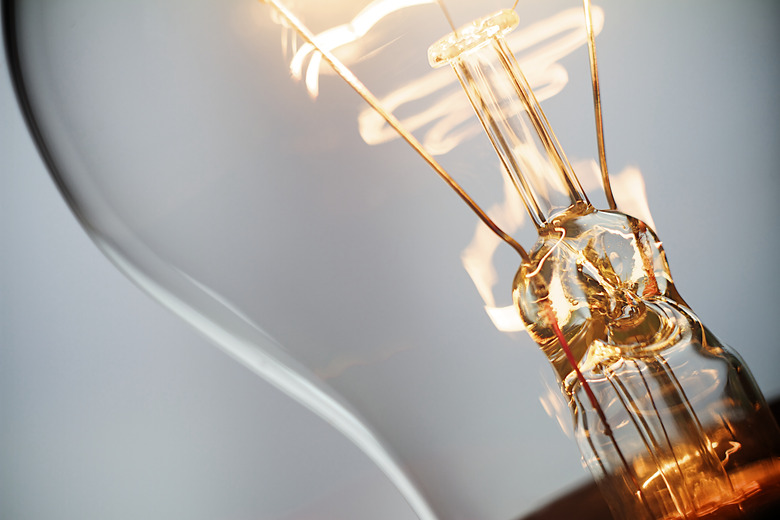How To Wire 12 Volt Lights To A 24 Volt System
Connecting a 12-volt light to a 24-volt power supply will destroy the bulb. Bulbs work within a narrow voltage range so excessive voltage will dramatically reduce its life and more probably melt the filament. However, by using two bulbs and the right wiring, or a single bulb and a resistor, you can safely run 12-volt bulbs from any 24-volt power supply.
Wiring Two Bulbs In Series
Step 1
Disconnect the power. Strip the outer insulation from the final quarter-inch of the wires running from the 24-volt supply. If the wire is of the filament type, twist the ends between your fingers to make them into tight bundles.
Step 2
Use an electrician's screwdriver to attach one battery wire to the base of a bulb-holder by wrapping it around the terminal and screwing it down tightly. Attach a short length of wire to the other bulb-holder terminal and join it to the second bulb holder. Attach the remaining terminal on the second bulb holder to the wire returning to the power supply.
Step 3
Insert bulbs into the holders. When the power is switched on, the first bulb's resistance will "use" 12 volts and leave 12 volts for the second bulb. Between them, they will use the full 24 volts. Both bulbs will light up and run on the 24-volt supply as if they have two 12-volt supplies.
Wiring One Bulb and a Resistor
Step 1
Reduce the voltage to 12 volts by adding a resistor to the circuit. Resistors lower voltage by converting some of the power into heat. Calculate the size of the resistor by finding the current drawn by the bulb. Examine the 12-volt bulb to find the wattage. Divide the wattage by the difference between the bulb voltage and 24 volts. For a 6-watt bulb this is:
\(\frac{6\text{ watts}}{24\text{ volts}-12\text{ volts}}=0.5\text{ amps}\)
The answer is the current, 0.5 amps.
Step 2
Divide the voltage difference — calculated in Step 1 — by the current to find the value of the resistor. Using the example, this gives:
\(\frac{24\text{ volts}-12\text{ volts}}{0.5\text{ amps}}=24\text{ ohms}\)
You need a 24-ohm resistor.
Step 3
Determine the power of the resistor so it won't overheat and fail. Electrical power, measured in watts, is found by multiplying the resistance by the current squared. Using the values found in steps 1 and 2, we get:
\(\text{power}=(24\text{ ohms})(0.5\text{ amps})^2=6\text{ watts}\)
The power, in this example, is 6 watts.
Step 4
Insert the appropriate resistor, 24 ohm rated at 6 watts in this case, into the wire leading to the bulb so the power flows through the resistor on its way to the bulb. When the power is switched on, the resistor will consume sufficient power to allow the light to function correctly.
Things Needed
- One or two 12-volt bulbs
- Resistor
- Insulated wire (about 12 inches)
- Electrician's screwdriver
TL;DR (Too Long; Didn't Read)
If you want to run an LED from a 24-volt battery use a 1,600 ohm resistor in series with a 3-volt LED.
If in doubt, always use a larger resistor than calculated, then reduce the size if the bulb glows dimly.
Warning
Most 24-volt supplies come from lead-acid automotive or marine batteries. They contain strong acid and should be treated with respect.
Do not wear metal jewelry or watches while working on these batteries. Touching metal across the battery terminals or wires will generate a very high current, sufficient to melt flesh.
Do not touch bulbs after they have been switched on. They can be extremely hot.
Cite This Article
MLA
Robinson, David. "How To Wire 12 Volt Lights To A 24 Volt System" sciencing.com, https://www.sciencing.com/wire-lights-24-volt-system-7670101/. 2 November 2020.
APA
Robinson, David. (2020, November 2). How To Wire 12 Volt Lights To A 24 Volt System. sciencing.com. Retrieved from https://www.sciencing.com/wire-lights-24-volt-system-7670101/
Chicago
Robinson, David. How To Wire 12 Volt Lights To A 24 Volt System last modified March 24, 2022. https://www.sciencing.com/wire-lights-24-volt-system-7670101/
